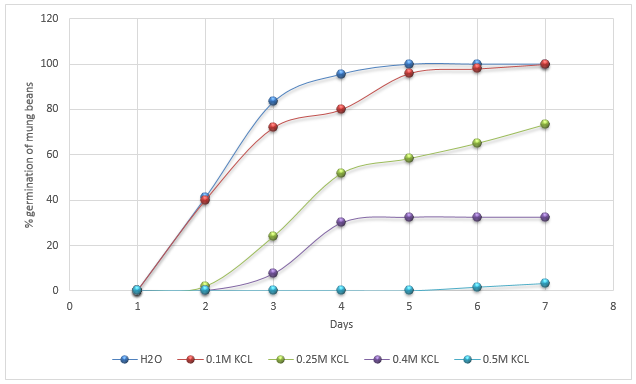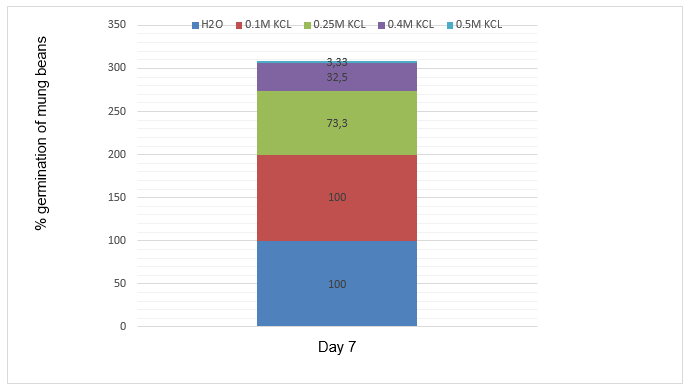Results
Table 1: showing percentage germination of mung beans in de-ionized water and at different concentrations of KCL.


Graph 2: showing the total growth of mung beans in de-ionized H2O and at different concentrations of KCl as at day 7 (the end of the experiment).
Discussion
Soil salinity is a key abiotic factor that is important in limiting plant yield and is responsible for unproductive land that accounts for approximately ninety-five million hectares the world over (Mine 239). Saline soils are responsible for undesirable effects in plants that include ion toxicity and rivalry. Furthermore, it results in some other detrimental effects due to osmotic potential.
Essentially, there are two key effects in plants that are understood to be the reason behind “high salt toxicity in plants” (Herr 45). These two include the osmotic and ionic effects. The latter is responsible for the change in enzymatic processes, and also influences the transportation of ions within the plant, eventuating in ion imbalance. Consequently, these effects manifest themselves on the overall rate of germination in seeds. Salt concentration is vital in influencing the rate of water intake in plants in a process called osmosis. Water is a vital component in the germination of seeds, acting as a medium through which the mineral salts are transported.
In this experiment, “the main objective was to study the effects of salt concentration on the rate of germination in mung beans” (Herr 46). As such, the above results (Table 1) were recorded, with mung beans recording maximum germination (100%) in the control and when in low salt concentration (at 0.1M KCL) as at the end of the experiment. Ideally, the total number of mung beans that germinated due course decreased with an increase in salt concentration from 0.1 to 0.5 Molar KCL.
Importantly, when the results of table 1 were plotted on the graph, the above trend (Graph 1) was observed, portraying the rates of growth under the different environments of salt concentrations. From the above trends, as expected, it is evident that the rate of growth of mung beans in both the control (de-ionized water) and at low salt concentration (0.1M KCL) was higher than when they were grown in the other salt concentrations. As shown by the slopes of the trends in graph 1, the rate of germination of mung beans decreases from DI H2O to 0.5M KCl.
To this end, it can be deduced that the recommended concentration of KCl to enhance germination of mung beans is 0.1M KCL. Essentially, all the trends assume sigmoid-shaped pattern, bringing the element of intra-specific competition among the mung beans as we approach day 7 (Neumann 98).
Essentially, the reason for the slow growth rate of mung beans in the higher salt concentrations (i.e. in 0.25, 0.4 and 0.5 M KCL), as expected, reflects on the osmotic and ionic effects. As it has been explained before, the rate of seed germination is a function of the salinity of the soil. As such, the rate of germination decreased with salinity. Increased salinity adversely affects osmotic potential, responsible for limiting water intake in the mung bean seeds. As a consequence, imbibition is hampered, resulting in delayed or no germination in extreme cases. The significance of water in seed germination cannot be ignored. Vitally, water is an important compound responsible for initiating seed growth.
It activates important metabolic processes that enhance embryo growth. Of note, it activates hydrolytic enzymes e.g. amylases vital in metabolizing stored food important for embryo development. The embryo shoots through a soft testa courtesy of imbibition. Importantly, the presence of high K+ and CL– ions on the growth of mung bean seeds might have been the reason for the trend witnessed in the above graph (graph 1). The presence “of these ions influences the absorption of other important elements, an effect that is greatly influenced by the reactivity series of elements” (Neumann 107). As such, ion imbalance occurs, limiting mung bean seed germination.
The summary of the aforementioned observation can be explained by the bar graph above (graph 2), portraying the total growth as at the end of the experiment. Just like it had been predicted, the total germination of mung bean seeds in the control (100%) was greater than when grown in the higher saline environment. Just like it had been predicted, increased salinity is the reason for the above observation, exhibiting negligible population of mung bean seeds that developed in 0.5M KCL.
Even though the above experiment portrayed the expected trends, the results can be improved in future experiments if the following errors can be eliminated. First, all the environmental factors including the humidity and light ought to be kept constant. As such, all the seeds would be subjected to a common environmental condition to yield a near-perfect result. Finally, the unevenness in the health of mung bean seeds greatly affects the outcome of the experiment. As such, future experiments need to emphasize on working with a bigger sample size to decimate this effect in order to yield more credible results.
Conclusion
In this “laboratory experiment, the main objective was to investigate the effect of salinity on the germination of seeds (mung beans)” (Neumann 107). A series of parallel experiments were performed; one with de-ionized water acting as a control and the others with 0.1, 0.25, 0.4 and 0.5M KCl. As expected, the results concurred with the theoretical explanation which predicts higher growth rate in de-ionized water as opposed to when in saline water.
The results showed mung beans population at 100% in de-ionized water and 0.1M KCl. The percentage germination as at day seven at 0.25, 0.4 and 0.5M KCl was 73.3, 32.5 and 3.3% respectively. The reason for these trends is that salinity influences osmotic potential, the ability for seeds to adsorb water vital for imbibition. Imbibition is an essential process that initiates the growth by activating hydrolytic enzymes and softening the testa to enhance the radicle to shoot.
With the elimination of experimental errors, future experiments can yield more credible results. To this end, performing the experiment under common environmental condition of humidity and light would help minimize the errors. Moreover, working with increased seed count would help reduce the effect of experimenting with unviable seeds.
Works Cited
Herr, Stephen. Effect of soil salinity on seed germination, Cambridge: Cambridge University Press, 2005. Print.
Mine, Ozkil. “Effect of different levels of NaCL and KCL on the growth of some biological indexes.” Pakistan Journal of Biological Sciences, 10.11 (2007): 1941-1943. Print.
Neumann, Marten. Inhibition of root growth by salinity stress, Amsterdam: Kluwer Academic Publishers, 2005. Print.